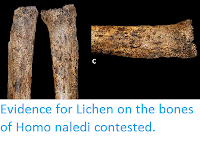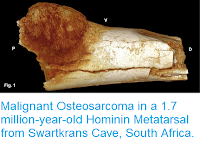In 2013 scientists in South Africa described the discovery of a
remarkable new Hominin species in the Dinaledi Cave System in Gauteng
State, South Africa (part of the Maropeng Cradle of Humankind World Heritage Site). Homo naledi was
similar to small Modern Humans in size, but had a cranial capacity more
typical of an Australopithicene and a post-cranial skeleton similar to
that of early members of the genus Homo.The remains have now been dated to between 236 000 and 335 000 years ago, and appear to have been deposited over a very short time period, though it is unlikely they were deposited in a single event. All of the remains were placed in close proximity, and largely disarticulated, making it difficult to assess the total number of individuals present in the chamber.
In a paper published in the South African Journal of Science on 30 January 2018, Debra Bolter of the Department of Anthropology at Modesto Junior College, and the Evolutionary Studies Institute at the University of the Witwatersrand, John Hawks and Barry Bogin, also of the Evolutionary Studies Institute at the University of the Witwatersrand, and of the Department of Anthropology at the University of Wisconsin-Madison, and Noel Cameron, again of the Evolutionary Studies Institute at the University of the Witwatersrand, and of the School of Sport, Exercise & Health Sciences at Loughborough University, use dental information to determine the number indiviuals on the Dinaledi Cave System, and the ages of these individuals.
A total of 190 teeth were recovered from the Dinali Chamber, of which 60 were in situ in sections of jaw, six partial mandibles, one complete mandible, and one partial maxila, with all of the other teeth being loose. Of these loose teeth, sixteen were considered too fragmentary for use in this study, leaving eight jaw fragments with teeth and 114 loose teeth for analysis.
Bolter et al. sorted the molar teeth and jaw fragments into six age classes; infants, in which no permanent molars were erupted, early juveniles, in which the first molar was erupted, late juveniles in which the second molar was erupted, sub-adults in which the third molars were erupted, but where there was little or no tooth wear, young adults, in which all molars are erupted and there is moderate tooth wear, and older adults in which all the molars are erupted, and there is heavy tooth wear.
There were a total of sixty four molar teeth in the assemblage, including those in jaw fragments, which, taking into account tooth type and side, represents a minimum of nine individuals. The jaw fragments comprise a complete mandible which articulates with the single fragment of maxila, and therefore represents a single individual, plus six mandible fragments. In the complete mandible and maxila all the molars are erupted and show moderate wear, leading Bolter et al. to conclude these came from a young adult. Of the seven mandible fragments, one contained an unerupted first molar, and was therefore assessed to be an infant, one had an erupted first and second molars and is therefore considered to be a late juvenile, one has all teeth erupted and heavily worn, and is considered an older adult, and three have all molars erupted, but no appreciable wear, and are therefore considered sub-adults.
(a) Infant left partial mandible with deciduous teeth and M1 crown in the crypt (unerupted). (b) Late juvenile right partial mandible with permanent erupted teeth labelled. (c) Adult full mandible with all permanent teeth labelled. (d) Old adult left partial mandible with permanent teeth very worn. Not to scale. Bolter et al. (2018).
This gave a minimum of seven individuals from the jaw fragments alone. Analysis of the isolated molars, and comparison of these to the jaw fragments revealed the presence of another five individuals, by assuming that each individual could have no more than three upper and three lower molars on each side, and that in each individual all of the molars would have roughly the same state of wear. These additional individuals comprise two infants, two early juveniles and an subadult, bringing the number of individuals to twelve.
Next Bolter et al. looked at the anterior teeth (incisors and canines). These are less useful for assessing age than molars, but the same principles of a maximum number of teeth per individual apply, and some age assessments can be made. Based upon this Bolter et al. deduce the presence of three more individuals, an early juvenile, an adult, and a juvenile or subadult, bringing the number of individuals to fifteen.
Fifteen individuals is too small a sample to undertake a full demographic analysis of Homo naledi population structures, but it is enough for some discussion of the issue. The sample represents three individuals that died as infants (20%), five that died as juveniles or subadults (33%) and seven that died as adults (47%). This is different from the pattern seen in Modern Humans living in hunter-gatherer societies, such as the Hadza people of northern Tanzania, who have an infant mortality rate of 52.7% and a juvenile mortality rate of 12.3%, or the Dobe !Kung of Namibia and Angola, who have infant mortality rate of 33.1% and a juvenile mortality rate of 7.4%. In wild Chimpanzees infant mortality rates vary between 30% and 60%, while the juvenile mortality rate is between 12% and 27%, closer to Modern Human hunter gatherers than Homo naledi. In Australopithecus afarensis specimens from Hadar in Ethiopia a similar pattern is seen, with a higher number of infants than juveniles, which leads Bolter et al to suggest that the Dinali remains may not reflect the true mortality pattern in Homo naledi, but rather an assemblage caused by some unusual event, such as a flash flood.
See also...
Follow Sciency Thoughts on Facebook.







